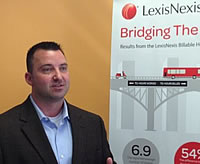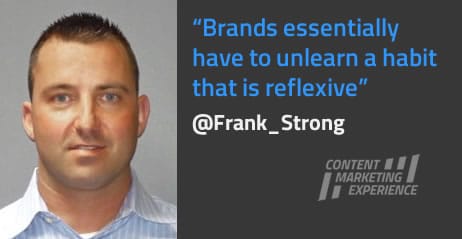
Forward-thinking PR professionals have embraced content marketing since quite some time now. Social, content, stories: it’s all related and connected. We talked about content marketing and PR (and social) earlier when covering an event with Deirdre Breakenridge and Shel Holtz.
The evolutions show in the market. Just think about what’s happening with Cision and Vocus, with the plans to combine both companies (former Cision and now Vocus CEO Peter Granat explained why that would make sense recently). Time for a deep dive (an appropriate term, as you’ll discover) with one of the industry’s professionals who was an early adopter of social, content marketing and PR: Frank Strong.
Frank Strong is a communications director with LexisNexis where he focuses his efforts on the software business. Prior to that he was director of public relations at just mentioned Vocus, which also owns familiar brands such as PRWeb, HARO, iContact and North Social. He’s also worked for PR agencies big and small. Frank often writes about content marketing in a branding (calling it the ‘new’ branding) or PR context. As an experienced practitioner he also knows about running content marketing operations and strategy.
Frank, can you start with telling us about the ways you have been using content marketing throughout your career?
Frank Strong: Even from my earliest days in PR working on the agency side, nearly everything we did (and still do) centers on content. Fifteen years ago, we didn’t call it “content” but that’s precisely what it was: pitches, press releases, fact sheets, backgrounders, media kits, speaking abstracts, contributed articles and analyst presentations – it’s all content. What’s changed really isn’t a change, but an evolution. The ability to connect directly with audiences and to build a community through self-publishing has never been easier or more cost-effective.
The distinction is nuance – but a very important nuance. For me the light bulb went off one day many years ago. I had pitched a story – a great story – to exhaustion. I pitched my best contacts with no luck. Not a single reporter responded. I couldn’t believe it – I knew this story had legs, I have a nose for a good news hook, had built a reputation as being source for good stories, and yet, even reporters I had known for years passed the pitch over.
Then I got a crazy idea: I took my pitch and turned it into a guest blog post. It was published and earned quite a bit of traction and in fact some of the very media outlets I had pitched (though not the same reporter) ended up linking to that post in subsequent coverage. I felt vindicated, but more importantly, I realized this was an effective means to build our own “media” through blogging.
Today I’m beyond a tipping point where a blog post is often a more effective means of media and blogger outreach than a pitch or a press release. PR should embrace content marketing.
The hardest part is getting organizational buy-in. I say organizational, because that’s very different from executive support. (Frank Strong)
Going agile, strategic and tactical
On your blog Sword and the Script, I found a post where you say ‘helpfulness is a better content marketing strategy, referring to the chest-thumping approach many organizations still have. Content marketing strategy is a pain point for many organizations. How do you advise marketers and brands to get a more strategic approach regarding content marketing?
Frank Strong: I’m very much in line with notion of agile marketing – experiment, tinker, refine and build it out. There are fundamental elements and education hurdles brands need to learn first. Some of these are technical, some are conceptual and some are in execution – such has relationship building through content.
Once a brand has had a chance to experiment, the goal is to take things to the next level. This means having a content plan – and aligning the content produced with business objectives. For example if a new product launch is forthcoming in six months, the content produced leading up to that launch should center on the pain that new product or service is going to solve.
That’s the big picture, but there are also important changes to a tactical level such as:
- Improving metrics including time on page or reducing bounce rates
- Goals and conversions for passing traffic to a relevant site for a transaction, including registrations
- Effective use of white space on a blog to align with these goals
Aspects like this, which often have an impact on revenue, are worth bringing in someone with experience, such as an SEO or ecommerce expert because subtle changes can have an enormous impact.

Content marketing to solve a problem
In one post I read “content marketing isn’t difficult, but by my observation, what brands struggle with the most is getting the collective minds wrap around the notion of utility over hype”. You told me you were a big fan of Jay Baer’s book YOUtility. What struck you in Jay’s book? What were your key takeaways?
Frank Strong: The thing I like the most about Jay is he comes at things from a very pragmatic perspective. You can read his content and walk away with an action item – something you can put in place immediately.
His book, YOUtilty makes the nuance of content marketing pretty clear and in plain language. Many brands are stuck on telling the market how great they are, rather than helping them solve a problem. A simple anecdote I like to use to explain this is about a plumber:
A marketing gal tells her client who is a plumber that he should make videos on YouTube about how to fix a sink. The plumber thinks this is a terrible idea – he’d be giving away the knowledge he’s gained over a career for free – and customers would watch his videos, fix their own sinks and never call him. He’s cannibalize his own business. The logic makes sense however, the reality is far different.
What will happens is prospective customers will watch those videos and call him to come fix their sink any way. More importantly, those same customers will share his videos with their friends and provide an endorsement. His videos are not hyping his services, they are helping customers understand the problem, establish trust and credibility.
This is the hardest part for brands to understand. They essentially have to unlearn a habit that is reflexive. I published a review of Jay’s book here: Book Review: 7 Take-Aways from Jay Baer’s YOUtility.
Back to that “content marketing isn’t difficult”. I can imagine that some marketers with complex go-to-marketing models and international operations might scratch their heads when reading that. Yet, many others will absolutely agree. I guess it’s a matter of context. What do you find to be the easiest and hardest parts of content marketing?
Frank Strong: The more complex the product or market, the more things a brand has to discuss – which means content marketing is even more important for those brands. This is especially true in products with a long sales cycle, because the marketing-to-sales continuum isn’t a funnel anymore, it’s a circle and prospects will enter that cirlce at different points with varying levels of content.
For me personally, and this has been true for years, the hardest part is getting organizational buy-in. I say organizational, because that’s very different from executive support. I can win over executive blessing with data and metrics, but changing the culture, facilitating a culture of content, is incredibly challenging. It can’t be done alone.
Content marketing and PR: on relationships and storytelling
You have quite some experience in PR and the PR industry. What are the key evolutions you have witnessed and how does content marketing affect the way PR is done?
Frank Strong: Similar to my anecdote in response to your first question, the most significant evolution is the ability to build relationships with – and through – content. A pingback is far more likely to earn a response than a pitch sent by email. The social sharing, the community conversations – that all centers on the content.
By my observation, PR pros are very slow to adopt to emerging trends. There are PR pros still tone-deaf to SEO. That ship sailed 10 years ago. PR has begrudgingly embraced social – they’ve been dragged kicking and screaming into the market conversation. Quite frankly, that’s all fine and well with me. I don’t mind a bit.
A while back you interviewed Lou Hoffman. Forgive me for not having heard of him before (I am an ocean away would be a possible, yet lame excuse) but the result was an interesting article on storytelling. While readers can check it out here, can you share some key takeaways and also some of your personal views and tips regarding storytelling?
Frank Strong: Lou is awesome. Amid an echo chamber of regurgitation, he brings fresh thinking. He owns a PR firm with more than 100 employees and yet he’s deep in the weeds. That’s something I greatly respect. His mother is pretty awesome too – and helps him with content.
I think the biggest takeaway is this: Eyeballs glaze over with data, but people remember stories. I’m not an especially religious man, but purely from a historical standpoint, few could argue the influence Jesus had on the world over the last 2,000 years. The man spoke in parables for a reason.
Short question: Content Marketing *is* PR. You know what I’m referring too. Please elaborate.
Frank Strong: I define PR as 3rd party validation. That definition fits neatly into what PR pros do, though I’d note it’s not just that we want people to say they identify with a brand or message, we want them to believe it too. That’s the difference between spin doctors and relationship builders.
In today’s world, if you want to reach people, the best PR strategy is to foster a community. A community can best be fostered with content, whether that’s a speech, a presentation or blog post. The links, the shares, the buzz that ensues is third-party validation.
Frank Strong under water and in the air: up close and personal

To conclude, some sentences I would love you to complete.
- Content marketing is…the integration of multiple marketing disciplines. It’s a beautiful thing.
- Although he doesn’t love chest-thumping, Frank Strong is most proud of his…his daughter; she taught me what unconditional love means.
- If he had to move to a deserted island with 3 books in his luggage, Frank Strong would pick…
- Jack London’s “Call of the Wild” for entertainment. I’ll never tire of re-reading that book.
- Neil Postman’s “Amusing Ourselves to Death” to understand how I landed on a deserted island.
- Joshua Piven and David Borgenict’s “The Worst Case Scenario Survival Handbook” – because it’s not getting read resting as a bathroom vanity.
- In the content marketing space, Frank Strong’s greatest sources of inspiration are…
- Mark W. Schaefer because he thinks differently.
- Lee Odden because he’s done it.
- Brian Solis

…and in the air – source Instagram because he’s proven there’s life after PR.
- Within five years from now…I’ll own a competitive agency in Raleigh-Durham.
- Skydiving is…like rebooting my mental hard drive.
- Life under water means…tranquility.
- What Frank Strong never mentioned online is…the mischief of a wayward youth.
- If Frank Strong would be an animal, he would definitely be…a leopard: Big enough to take down prey, small enough to avoid a losing battle.
- The best things in life…are love, waking up well-rested and 1.5 ounce glass of something red.
- My friends call me…Strong. And don’t call me Francis because with a last name like Strong, you’ll ruin my image.
Thanks, Frank Strong, for your views and this interview! We will never call you Francis and take care, under water and in the air (that rhymed).
More about content marketing and PR: Social, content and PR: connecting the human dots.

